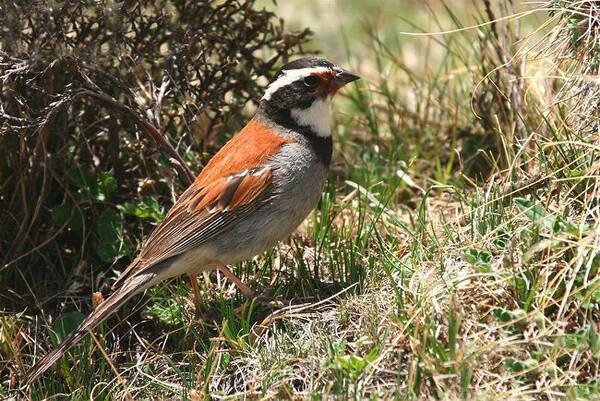Emberiza koslowi
IUCN
LCBasic Information
Scientific classification
- name:Emberiza koslowi
- Scientific Name:Tibetan Bunting,Emberiza koslowi,
- Outline:Songbird
- Family:Passeriformes Pipitidae Pipitidae
Vital signs
- length:17-19cm
- Weight:25-29.5g
- lifetime:No verification information
Feature
It has a distinctive bright red chestnut back, a black band on the upper chest, and a solid grey under chest.
Distribution and Habitat
It is a species endemic to China. It is distributed in Zaduo, Qumalai in southern Qinghai, Henan County in the southeast of the Qinghai-Tibet Plateau, and the upper reaches of the Lancang River in the northern part of the Qamdo area of Tibet.
This bird belongs to alpine meadow, grassland and shrub birds, and inhabits the mountain willow shrub area of the Qinghai-Tibet Plateau. It likes open and barren alpine shrubs, dwarf cypress bushes, rhododendron forests and bare ground above the forest line. It is 3600-4600 meters above sea level in southeastern Qinghai and eastern Tibet. There is no record south of 31°N.
Appearance
Adult male: The top of the head, back of the neck, ear feathers and sides of the neck are all black; the eyebrow is white, extending from the base of the beak to the back of the neck; the front of the eyes and the front cheeks are reddish brown; the upper back and shoulders are bright chestnut, and the waist is dark gray; there is a blue-gray horizontal band between the back of the neck and the upper back, extending down to the lower chest; except for the large coverts on both wings, the rest of the coverts are mostly dark blue-gray, the primary coverts and flight feathers turn black-brown, and the outer edge of the primary flight feathers gradually turns to the same color as the back; the tail feathers are black-brown; the two pairs on the outside are pure white except for the base of the feathers and part of the outer vanes; the chin and throat are white; there is a wide black band on the upper chest, connected to the black on the sides of the neck; the lower chest is blue-gray and e
Details
Tibetan Bunting is a small songbird with no subspecies.

Tibetan Bunting usually moves alone or in pairs, and forms small groups in winter. It hides when seeing people approaching. Although it flies at a very low altitude, it is not easy to observe. They move quickly in the bushes, often jumping from low branches to high branches, with their tails lifted high. They sing loudly, especially the male birds. This is a songbird that is good at singing. It is also a small bird with a strong sense of territory. The song is a short chirping sound similar to the Gouldian rock bunting. The flight call is tsip tsip, and the communication call is a thin and long seee sound. The food is mainly insects, pecking includes Lepidoptera larvae, Diptera Tipulidae, Orthoptera Acrididae, Cricketidae, Coleoptera Golden Caterpillars, Ground Beetles, Hemiptera Pentatomidae, Hymenoptera Ants and other small insects, spiders and some aquatic animals. In autumn, they also peck a small amount of berries. The chicks are mainly fed with locusts, crickets, caterpillars, mainly Lepidoptera larvae.
The World Wildlife Fund (WWF) and the Critical Ecosystem Partnership Fund (CEPF) funded the Golog Prefecture of Qinghai Province, China to investigate the distribution and reproduction of the rare Tibetan Bunting and implement necessary protection. From spring to autumn in 2007, only 48 Tibetan Buntings were found per month in the nearly 600 square kilometers of Baiyu Township. The investigators only found the only Tibetan Bunting nest on July 25, which was hidden in the footprints of yaks in the weeds. The Tibetan Bunting chose the footprints made by yaks in winter as the nest site in the summer, indicating that this winter pasture was well rested in the summer without human and animal interference. The project team speculated that if these winter pastures were converted to year-round grazing pastures, it might have a huge impact on the reproduction of Tibetan Buntings in Baiyu Township. Therefore, the project team discussed with local farmers to retain the original grazing method in specific areas, that is, no grazing in summer. Fortunately, a farmer agreed to designate the "Amulonggou" where his winter pasture is located as a Tibetan bunting protection area and erected a sign at the entrance of the gully.
Although the Tibetan bunting was caught by the camera, there is still a lot of work to be done to uncover its mysterious veil and restore its population. Surveys show that the number of Tibetan buntings is much smaller than expected, and there is a surprising lack of breeding records. Even high-density observations have failed to obtain enough information. How they reproduce and how they feed their young birds remains a mystery.
Listed as a rare species in the "China Red Book of Endangered Animals·Birds"
Listed in the "National List of Terrestrial Wildlife with Important Economic and Scientific Research Value" (Item 700) issued by the State Forestry Administration of China on August 1, 2000.
Listed in the "Red List of Endangered Species of the World Conservation Union" (IUCN) 2016 ver 3.1-Near Threatened (NT).
Listed in the second level of China's "National Key Protected Wildlife List" (February 5, 2021).
Protect wild animals and stop eating game.
Maintaining ecological balance is everyone's responsibility!








